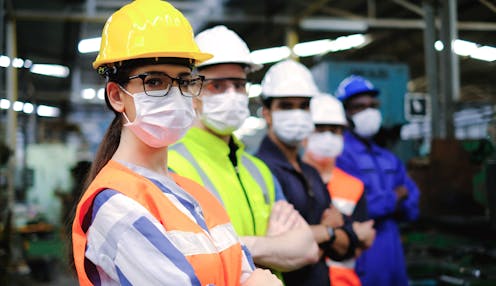Why it's more important than ever for workplaces to have staff well-being plans
- Written by Dougal Sutherland, Clinical Psychologist, Te Herenga Waka — Victoria University of Wellington

A recent survey of New Zealand workplaces revealed more than a third have no workplace well-being plan in place. Yet it is necessary, now more than ever, for organisations to understand what a healthy work environment looks like and to provide it for their employees.
The 2015 Health and Safety at Work Act requires workplaces to look after the physical and mental health and well-being of their staff. This means looking at work through a health and safety lens and understanding the risks that affect people’s well-being at work.
For many organisations, the legislation took them into new and unknown territory. Our experience working with organisations was that, understandably, many efforts initially focused on managing stress and mental illness only after they occurred.
However, evidence clearly points to the importance of having a proactive strategy to prevent psychological harm occurring in the first place – having the fence at the top of the cliff as well as the ambulance at the bottom.
The issue of workplace burnout has received lots of attention of late, particularly in relation to people working in the health sector. But, even beyond this, there is clear evidence aspects of work design, organisation and management as well as employees’ social and environmental context play a major role in workers’ psychological and physical health.
Read more: A burnt-out health workforce impacts patient care
These psychosocial factors should be the focus of workplace well-being plans. Failure to address them can directly contribute to mental health problems in employees, including depression.
Recommendations for a well-being plan
A recent World Health Organization (WHO) report on mental health listed three key recommendations to prevent mental ill health at work:
organisational interventions to identify, remove or mitigate psychosocial risks
mental health training for managers to identify and support healthy work practices and healthy workers
interventions for employees to increase their personal coping capacity.
Historically, many workplaces have focused on the last recommendation. But to focus solely on boosting individuals’ coping abilities can place the blame on the person and mask the impact of broader environmental factors.
Our experience working with organisations suggests interventions that only target individuals and not the broader organisation implicitly give the message that employees are to blame if they’re not “resilient enough” to cope with overwhelming workloads and unmanageable deadlines.
Individually focused interventions can also be met with cynicism and lack of buy-in from employees.
Feedback from managers and staff leaders indicates many have monitored employee well-being implicitly and spontaneously in the past (for example, noting when a team member is looking down or feeling upset). But with many workplaces moving to hybrid models of staff working partly from home, these strategies may no longer be effective.
Training managers to spot signs of languishing in people working remotely is a new but much-needed component of many well-being plans.
Read more: Languishing: what to do if you're feeling restless, apathetic or empty
Considering employees’ personal circumstances
There are a few tips organisations should keep in mind when implementing these recommendations.
Firstly, it’s crucial to ask employees about what is stressing them. Use this information as a basis for your plan. It is vital to use a form of survey or assessment developed specifically for this purpose, rather than just guessing or assuming you know what your people think. This means you can track changes in well-being over time.
Secondly, involving employees in the design of any well-being plan will likely increase buy-in and improve uptake of any interventions.
Thirdly, employers need to consider both work and non-work factors. Some work factors may be obvious (such as bullying, high workload, exposure to traumatic material), while others may be less so (level of autonomy at work, being consulted about change) yet still critical. Non-work factors may include financial stress and parenting or relationship difficulties.
Some organisations may blanch at the thought of a workplace helping with aspects of employees’ private lives. But to do so may be a crucial component in contributing towards their well-being.
In addition to reducing risks, a good well-being plan promotes positive aspects of a workplace. These are the things that make employees want to be there, such as a great office environment, a culture of appreciation, and “fringe benefits” that come with the job.
Psychological well-being in the workplace may still be relatively new territory for many organisations and it’s tempting to pluck the low-hanging fruit by simply providing some extra tools to workers. A comprehensive well-being plan that addresses psychosocial factors will help expand interventions and prove the old adage that prevention is better than cure.
Amanda Wallis and Erika Clarry, at Umbrella Wellbeing, have contributed to this article.
Authors: Dougal Sutherland, Clinical Psychologist, Te Herenga Waka — Victoria University of Wellington





